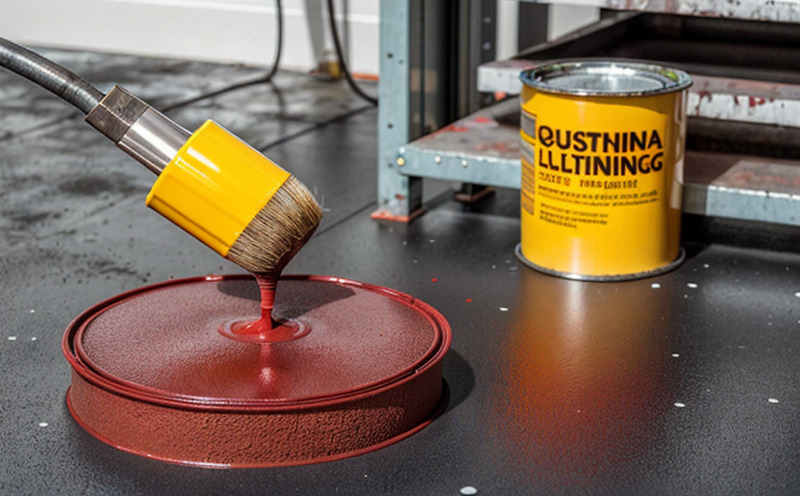ASTM D2247 Humidity Resistance Testing of Coatings
The ASTM D2247 standard is a critical tool in ensuring that coatings and paints are capable of withstanding exposure to humid environments. This testing protocol evaluates the resistance of coating specimens to water vapor absorption, which can lead to changes in color, gloss, or adhesion properties under humid conditions.
This test is particularly important for industrial coatings used in sectors such as transportation, construction, and marine applications where environmental factors play a significant role in material performance. The testing process involves exposing coated specimens to controlled humidity levels and temperatures over an extended period. This exposure simulates real-world conditions that the coating may encounter during use.
The ASTM D2247 test is conducted using a Humidity Chamber or Humidifier, which maintains precise temperature and relative humidity conditions for the duration of the test. Specimens are typically exposed to high humidity levels (93% RH) under specific temperatures (60°C). The exposure time varies depending on the desired outcome; however, it is generally set at 100 hours.
Following the test, specimens undergo inspection and measurement for any changes in appearance or mechanical properties. Common tests include visual examination for color change or loss of gloss, adhesion testing using methods such as cross-cut tape tests, and other physical property evaluations like hardness or impact resistance.
The ASTM D2247 standard is widely recognized and accepted by regulatory bodies and industries worldwide. Compliance with this test ensures that coatings meet the required standards for durability and performance in humid environments.
In real-world applications, ASTM D2247 testing can help manufacturers identify potential issues early on during product development stages or quality control processes. By understanding how a coating responds to humidity resistance, companies can make informed decisions about ingredient selection, formulation adjustments, and process improvements.
The results of the ASTM D2247 test are essential for ensuring that coatings used in various industrial applications meet strict performance requirements set by international standards organizations like ISO, ASTM, EN, IEC, etc. These tests contribute significantly to maintaining high-quality products while also promoting sustainability practices within manufacturing processes.
Applied Standards
| Standard Code | Description |
|---|---|
| ASTM D2247-19 | Standard Practice for Conducting Humidity Resistance Tests on Coatings. |
| ISO 6272:2008 | Paints and varnishes – Determination of water resistance by immersion in distilled water at 50°C. |
| EN ISO 16092-4 | Performance testing of protective coatings – Part 4: Humidity resistance test for organic protective coatings on metallic substrates. |
| IEC 60068-2-75 | Determination of water vapor permeability of insulating materials and electrical apparatus parts by means of a humid atmosphere. |
International Acceptance and Recognition
The ASTM D2247 test is recognized globally for its reliability in assessing the humidity resistance properties of coatings. Regulatory bodies, such as the U.S. Food and Drug Administration (FDA), European Union's New Approach to Industrial Products Regulation (NPR), and others mandate compliance with this standard.
Manufacturers from various countries rely on ASTM D2247 testing to ensure their products meet local and international standards. This ensures consistent performance across different regions, reducing the risk of product failure due to environmental factors like humidity exposure.
In addition to regulatory requirements, many companies voluntarily adopt ASTM D2247 as part of their quality assurance programs. By adhering to this standard, they demonstrate their commitment to producing high-quality coatings that can withstand challenging environmental conditions.
Environmental and Sustainability Contributions
The ASTM D2247 test plays a crucial role in promoting environmentally friendly manufacturing practices by ensuring that industrial coatings are durable enough to last longer without compromising performance. This reduces waste associated with frequent reapplication or replacement of damaged coatings.
By selecting materials that pass rigorous humidity resistance tests like ASTM D2247, manufacturers contribute positively towards reducing the carbon footprint of their products throughout their lifecycle. Furthermore, this testing helps reduce energy consumption during production processes by minimizing the need for additional treatments or modifications after initial application.
The results of these tests also encourage innovation in sustainable coatings development, leading to advancements that minimize environmental impact while maintaining optimal performance levels. As sustainability becomes increasingly important across all industries, compliance with standards such as ASTM D2247 will continue to play a vital role in driving positive change within the manufacturing sector.





